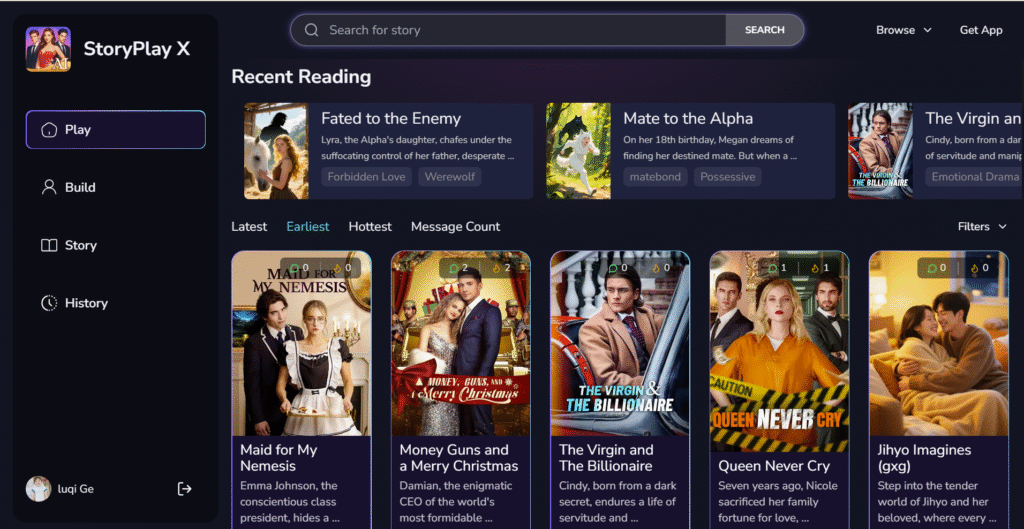Table of Contents
In the realm of psychological thrillers and revenge dramas, Mommy Don’t Cry Daddy is Sorry has emerged as a compelling narrative that challenges our understanding of grief, betrayal, and the lengths a mother will go to protect her child. This gripping short drama has sparked countless discussions and creative interpretations across storytelling platforms, making it a perfect canvas for fan fiction and creative reimagining.
The Twisted Tale Behind Mommy Don’t Cry Daddy is Sorry
At its core, Mommy Don’t Cry Daddy is Sorry presents a narrative that’s both heart-wrenching and thrilling. The story follows Wayne, a grieving husband who believes his wife Sienna has died in a mental hospital. However, the plot takes a sinister turn when the manipulative Alison deceives him into taking home the wrong daughter. What Wayne doesn’t realize is that his wife has survived, transformed into her fierce alter-ego Scarlett, ready to expose Alison’s treacherous schemes and seek vengeance for her daughter.
This premise taps into universal themes of parental love, deception, and the psychological transformation that trauma can trigger. The duality of Sienna/Scarlett represents not just a character arc but a metaphor for how grief and betrayal can fundamentally change a person’s identity. Mental health narratives have become increasingly important in modern storytelling, reflecting society’s growing awareness of psychological complexity and the need for nuanced representations of trauma and recovery.
The hospital setting itself serves as more than mere backdrop. It represents institutional power, questions of agency, and the thin line between protection and imprisonment. These elements provide rich thematic material for creators looking to explore deeper societal issues through the lens of personal drama. The transformation from victim to survivor, from Sienna to Scarlett, mirrors real-world experiences of those who have faced institutional trauma and emerged changed but empowered.

Why Mommy Don’t Cry Daddy is Sorry Resonates with Modern Audiences
The popularity of Mommy Don’t Cry Daddy is Sorry stems from its ability to blend multiple genres seamlessly. It’s part psychological thriller, part family drama, and part revenge story. This multifaceted approach gives creators enormous flexibility when developing their own interpretations through platforms like Storyplay X.
According to Psychology Today, revenge narratives appeal to our sense of justice and provide cathartic release. This story exemplifies this perfectly by presenting a protagonist who transforms from victim to avenger, embodying the power fantasy many viewers crave. The psychological transformation at the heart of the narrative speaks to contemporary audiences who understand that strength often emerges from vulnerability, and that survival sometimes requires becoming someone entirely new.
Character Complexity in Mommy Don’t Cry Daddy is Sorry
What makes Mommy Don’t Cry Daddy is Sorry particularly compelling for creative reinterpretation is its rich character development. Wayne represents the archetypal grieving father, blinded by loss and vulnerable to manipulation. His journey from mourning husband to shocked discoverer of the truth provides ample material for exploring themes of guilt, redemption, and the consequences of misplaced trust.
Wayne’s character raises fascinating questions about culpability and awareness. How much responsibility does he bear for falling for Alison’s deception? His grief makes him sympathetic, yet his failure to recognize his own daughter creates complex moral territory. This ambiguity offers creators opportunities to explore different interpretations: Is Wayne a victim of circumstances, or does his emotional blindness make him complicit in the tragedy?
Sienna’s transformation into Scarlett offers creators a fascinating dual character to work with. This Jekyll-and-Hyde dynamic allows for exploration of mental health themes, the impact of institutional trauma, and the protective instincts of motherhood pushed to their extreme. The question of whether Scarlett is a psychological coping mechanism, a complete personality shift, or something more supernatural remains deliberately ambiguous, allowing for multiple creative interpretations.
The Creative Potential of Mommy Don’t Cry Daddy is Sorry on Storyplay X
Storyplay X has become the go-to platform for creators looking to reimagine stories like Mommy Don’t Cry Daddy is Sorry. The platform’s interactive features allow writers to explore alternate endings, develop side character perspectives, and even create prequel content that explains how the characters arrived at their fateful circumstances.
The platform’s unique tools enable creators to build branching narratives that respond to reader choices. Imagine a version where readers can influence Wayne’s decisions, potentially helping him see through Alison’s deception earlier. Or consider stories that follow the wrong daughter’s perspective, exploring her confusion and eventual realization of her role in this twisted plot. These interactive elements transform passive consumption into active participation, creating a more immersive and personalized experience.
Collaborative features on Storyplay X allow multiple creators to build shared universes around the original narrative. One writer might focus on the medical staff at the hospital, exploring the ethical dilemmas they faced. Another could delve into Alison’s past, revealing the events that shaped her into someone capable of such cruelty. These interconnected stories create a richer, more complex narrative world that extends far beyond the original plot.
Similar to how The Guardian reports on the evolution of fan fiction into mainstream literature, this story represents a new wave of source material that invites active participation from its audience rather than passive consumption. The democratization of storytelling through platforms like Storyplay X has created opportunities for diverse voices to contribute their perspectives, enriching the original narrative with cultural nuances and personal experiences.

Themes and Symbolism Worth Exploring
The depth of Mommy Don’t Cry Daddy is Sorry extends beyond its plot twists. The mental hospital setting raises questions about institutional power, medical ethics, and society’s treatment of mental health. These themes resonate particularly strongly in contemporary society, where discussions about mental health care, patient rights, and institutional accountability have become increasingly prominent.
The concept of identity runs throughout the narrative like a twisted thread. Who is the real Sienna? Is Scarlett a separate entity or an evolved version of the same person? The wrong daughter adds another layer to this identity crisis, raising questions about nature versus nurture, and whether family bonds are defined by blood or experience. These philosophical questions provide rich material for creative exploration.
Scarlett’s emergence as Sienna’s alter-ego can be interpreted as a survival mechanism, a supernatural transformation, or a metaphor for the masks we wear to navigate trauma. This ambiguity is intentional and valuable, allowing creators to choose their own interpretation based on the story they want to tell. Some might explore it as a realistic psychological phenomenon, while others might venture into supernatural or symbolic territory.
The wrong daughter element touches on themes of belonging and the nature of family bonds. Is family defined by blood or by the connections we choose? How does a child process being used as a pawn in adult manipulations? The innocence of children caught in adult schemes adds emotional weight to the narrative, providing opportunities to explore how trauma affects the youngest and most vulnerable.
Power dynamics permeate every relationship in the story. From the institutional power of the hospital to Alison’s manipulation of Wayne’s grief, to Scarlett’s reclaimed agency, the narrative constantly examines who holds power and how they wield it. This makes it particularly relevant for contemporary creators interested in exploring themes of empowerment, systemic oppression, and individual agency.
Building Your Own Mommy Don’t Cry Daddy is Sorry Universe
When approaching Mommy Don’t Cry Daddy is Sorry as source material for your own creative work, consider the story’s core emotional beats. The betrayal, the transformation, the quest for justice – these elements can be transplanted into different settings while maintaining the story’s essence. Perhaps your version takes place in a corporate setting, with industrial espionage replacing the hospital drama. Or maybe you’ll set it in a fantasy realm where Scarlett’s transformation is literal magic.
Historical settings offer particularly interesting possibilities. Imagine this narrative set during the Salem witch trials, where accusations of madness and supernatural transformation take on deadly serious implications. Or transport it to Victorian England, where asylums were notorious for imprisoning inconvenient women. Each setting brings its own cultural context and additional layers of meaning to the core narrative.
Futuristic interpretations might explore themes of identity through technology. Perhaps Sienna’s transformation into Scarlett involves consciousness transfer or AI augmentation. The wrong daughter could be a clone or android, raising questions about what makes someone “real” family. Science fiction settings allow creators to literalize metaphors from the original story in fascinating ways.
The beauty of working with this narrative on Storyplay X is that the platform encourages experimentation. You can create branching narratives where readers choose whether Wayne believes Alison or begins to doubt her story. You might develop a version where Sienna and Scarlett exist as separate entities, each fighting for control of the narrative. The platform’s tools make it easy to manage complex, branching storylines that would be impossible in traditional media.
Technical Storytelling Techniques
Successful adaptations of Mommy Don’t Cry Daddy is Sorry often employ specific narrative techniques that enhance the psychological tension. Unreliable narration works particularly well, as the original story plays with perception and deception. When every character has reasons to lie or misperceive reality, readers must actively engage with the text to discern truth from fiction.
Perspective shifts can dramatically alter how readers understand events. A chapter from Alison’s point of view might initially make her seem sympathetic, only for later revelations to recontextualize her actions as manipulative. The wrong daughter’s innocent observations could provide dramatic irony, as she unknowingly reveals crucial information about the deception surrounding her.
Flashbacks serve multiple purposes in adaptations of this narrative. They can reveal the true nature of relationships, showing the happy family before tragedy struck. They might expose Alison’s careful planning, building tension as readers see how long the deception has been in motion. Alternatively, flashbacks to Sienna’s time in the hospital can gradually reveal her transformation, building sympathy for her eventual actions as Scarlett.
As noted by MasterClass, psychological thrillers benefit from tight pacing and strategic revelation of information. When crafting your own version on Storyplay X, consider how you’ll control the flow of revelations for maximum emotional impact. The platform’s interactive features allow you to gate information behind reader choices, creating a more personalized revelation experience.
Symbolism and metaphor enrich any adaptation. The hospital might represent societal constraints on women, while Scarlett’s emergence symbolizes breaking free from those constraints. The wrong daughter could symbolize innocence corrupted or the arbitrary nature of family connections. Weather, colors, and recurring images can all serve to reinforce themes and create atmospheric consistency throughout your narrative.

Community and Collaboration
One of the most exciting aspects of working with Mommy Don’t Cry Daddy is Sorry on Storyplay X is the collaborative potential. The platform’s community features allow creators to build upon each other’s work, creating a rich tapestry of interconnected stories all stemming from the original premise.
Community challenges and prompts regularly inspire new interpretations. A “perspective flip” challenge might encourage writers to tell the story from Alison’s point of view, revealing her motivations and humanizing her actions. A “genre swap” event could produce versions ranging from space opera to medieval fantasy, each maintaining the core emotional conflicts while exploring them in radically different contexts.
Collaborative world-building allows multiple creators to establish shared rules and backgrounds for their interpretations. Perhaps a group decides that in their shared universe, the hospital is actually a front for supernatural experiments, explaining Sienna’s transformation. These collaborative efforts create consistency across multiple stories while still allowing individual creative freedom.
Mentorship opportunities within the Storyplay X community help new creators develop their skills. Experienced writers who have successfully adapted the narrative can guide newcomers, sharing techniques for maintaining tension, developing character voice, and managing complex plot threads. This supportive environment encourages experimentation and growth.
Reader feedback systems on Storyplay X provide valuable insights for creators. Interactive polls can help writers decide plot directions, while comment sections allow for deep discussions about character motivations and thematic interpretations. This immediate feedback loop helps creators refine their work and better understand what resonates with audiences.
The Future of Interactive Storytelling
As we look toward the future of digital storytelling, Mommy Don’t Cry Daddy is Sorry represents a perfect example of how traditional narratives can evolve in the digital age. The story’s complex emotions and moral ambiguities make it ideal for interactive exploration, where readers can examine different facets of the characters’ motivations and choices.
Emerging technologies promise even more immersive storytelling experiences. Virtual reality adaptations could place readers directly in Wayne’s shoes, experiencing his grief and confusion firsthand. Augmented reality might overlay story elements onto real-world locations, creating location-based narrative experiences that blur the line between fiction and reality.
AI-assisted writing tools on platforms like Storyplay X are beginning to help creators manage complex branching narratives more easily. These tools can track plot consistency across multiple story branches, suggest character actions based on established personality traits, and even generate dialogue in character-specific voices. This technological assistance allows creators to focus on the creative aspects of storytelling while managing technical complexity.
The rise of transmedia storytelling offers exciting possibilities for expanding narratives beyond text. Creators might develop audio dramas that explore character’s internal monologues, visual novels that bring the hospital setting to life, or even interactive video experiences where viewers’ choices determine story outcomes. Storyplay X’s support for multiple media formats makes these ambitious projects achievable for independent creators.
Community-driven content curation is reshaping how stories reach audiences. Rather than traditional publishing gatekeepers, reader communities on Storyplay X vote on which adaptations rise to prominence. This democratization ensures that diverse voices and unconventional interpretations can find their audience, enriching the overall narrative landscape.
FAQ About Mommy Don’t Cry Daddy is Sorry
What makes Mommy Don’t Cry Daddy is Sorry suitable for creative adaptation?
The complex characters, psychological depth, and moral ambiguity provide rich material for reinterpretation. The story’s themes of betrayal, identity, and revenge resonate across different genres and settings. Additionally, the narrative’s open-ended elements and unanswered questions invite creative exploration and expansion.
How can I start creating my own version of Mommy Don’t Cry Daddy is Sorry on Storyplay X?
Begin by identifying which aspect of the story speaks to you most. Is it the psychological transformation, the family betrayal, or the revenge plot? Use Storyplay X’s templates and community resources to develop your unique take. Start with character profiles, outline your core themes, and consider how your chosen genre or setting will reshape the narrative. The platform’s tutorial system guides new creators through their first project.
Can I change the setting or time period of Mommy Don’t Cry Daddy is Sorry?
Absolutely! The core themes translate well across different settings. Many successful adaptations on Storyplay X have reimagined the story in various historical periods, fantasy worlds, or even futuristic settings. The key is maintaining the emotional core while allowing the new setting to bring fresh perspectives and challenges to the characters.
What if I want to focus on a minor character from Mommy Don’t Cry Daddy is Sorry?
Expanding on minor characters is a popular approach to adaptations. The hospital staff, the real daughter, or even new characters you create can provide fresh perspectives on the original events. Minor character focus allows you to explore untold aspects of the story while maintaining connection to the source material.
Conclusion: Your Story Awaits
Mommy Don’t Cry Daddy is Sorry has proven itself to be more than just a compelling short drama – it’s a launching pad for countless creative explorations. Whether you’re drawn to its psychological complexity, its emotional depth, or its thrilling plot twists, Storyplay X offers the perfect platform to make this story your own.
The journey from passive viewer to active creator begins with recognizing the potential within stories that challenge us emotionally and intellectually. Every reader brings their own experiences and perspectives, creating unique interpretations that enrich the original narrative. Through Storyplay X, these individual visions can become fully realized stories, shared with a community of fellow creators who appreciate the art of transformative storytelling.
The tools available on Storyplay X democratize storytelling in unprecedented ways. No longer do creators need extensive technical knowledge or industry connections to share their vision. The platform’s intuitive interface, supportive community, and powerful features put professional-quality storytelling tools in everyone’s hands. Whether you’re a seasoned writer or someone who’s never shared their creative work before, Storyplay X provides the support and resources needed to bring your interpretation to life.
Don’t just watch – reimagine it, reshape it, and make it uniquely yours. The tools are waiting, the community is supportive, and your version of this captivating story deserves to be told. Join thousands of creators who have already discovered the joy of transforming beloved narratives into something entirely new. Your unique perspective could be exactly what the community has been waiting for.
Start your creative journey today on Storyplay X. Whether you contribute a single chapter or build an entire alternate universe, every creation adds to the rich tapestry of storytelling that makes our platform special. The only limit is your imagination, and with a narrative as rich as this one, inspiration is endless.

The character complexity in ‘Mommy Don’t Cry Daddy is Sorry’ really makes it stand out. Wayne’s emotional journey from grief to revenge is heartbreaking, yet strangely relatable. It’d be interesting to explore how these themes of loss and betrayal would play out in a different time period or setting.